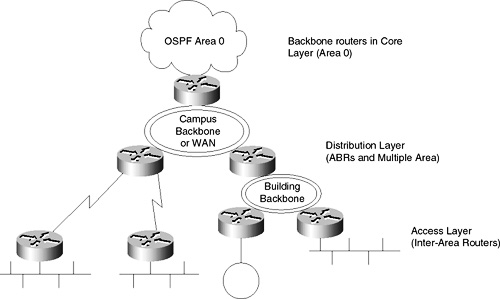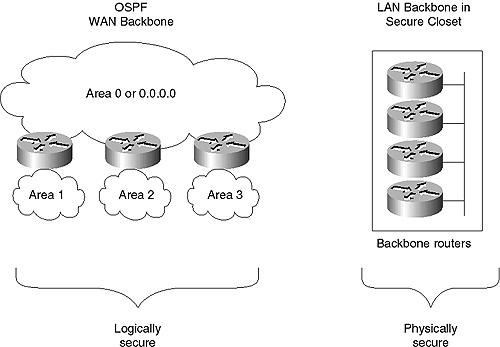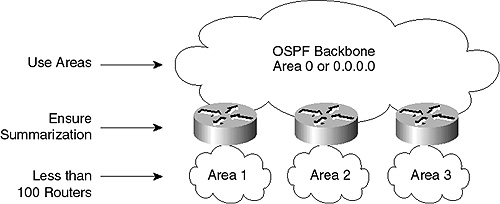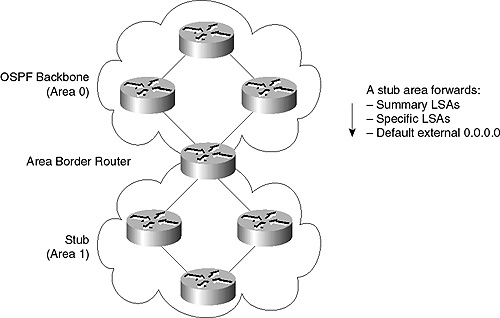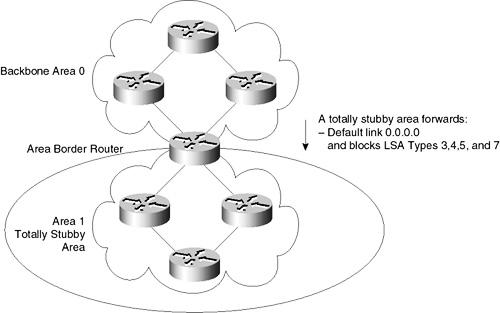Designing Implementing an OSPF Network
Hierarchical Topology In a hierarchical topology, the network is organized in layers that will have clearly defined functions. In this type of network there are three layers:
By using this type of logical layered network design, you will gain some benefits that will help you design the network as shown in Figure 7-4.
The benefits of the OSPF hierarchical topology as implemented in Figure 7-4 are as follows:
There are other variations of the three-layered hierarchical design that are available are one layer—distributed, hub and spoke—and two layers, but they are beyond the scope of this book. At this point, though, you can see that the three layered hierarchical model fits perfectly into OSPF’s logical design, and it is this model on which you will be basing your network design. Before discussing how to implement and design this type of model, you need some basic OSPF backbone design suggestions. OSPF Backbone Design in the Hierarchical Model The process of designing the backbone area has been previously discussed, so it will be only briefly reviewed here. Always keep the backbone area as simple as possible by avoiding a complex mesh. Consider using a LAN solution for the backbone. The transit across the backbone is always one hop, latency is minimized, and it is a simple design that converges very quickly. Figure 7-5 illustrates a simple OSPF backbone design.
You know that you should keep users off the backbone because it is only a transit area, but that is not enough. You also need to consider securing your backbone physically. As a network critical shared resource, the routers need to be physically secure. If you use the previously mentioned LAN backbone solution, then securing your network can be relatively easy; just put it in a secure closet or rack as shown in Figure 7-6.
Areas: Stub, Totally Stubby, or Not-So-Stubby You will have to design your OSPF network with areas to make the network scalable and efficient. Areas have been discussed in previous chapters, but let’s briefly review them at this point. Areas should be kept simple, stubby, with less than 100 (optimally 40-50) routers, and have maximum summarization for ease of routing. The network illustrated in Figure 7-7 demonstrates these suggestions.
Even though these design suggestions are helpful, what are you really going to gain in your network by adding stub areas? Simply put, they will summarize all external LSAs as one single default LSA that applies only to the external links from outside the autonomous system. The stub area border router sees all the LSAs for the entire network and floods them to other stub area routers. They keep the LSA database for the stub area with this additional information and the default external route. Figure 7-8 illustrates the operations in a stub area.
There are also totally stubby areas that you could design within your network. Totally stubby areas are a Cisco-specific feature available within their implementation of the OSPF standard. You can use totally stubby areas in Cisco IOS Release 9.1 and later. If an area is configured as totally stubby, only the default summary link is propagated into the area by the ABR. It is important to note that an ASBR cannot be part of a totally stubby area, nor can redistribution of routes from other protocols take place in this area. Figure 7-9 shows the operations in an example totally stubby area.
The main difference between a stub area and a not-so-stubby area (NSSA) is that the NSSA imports a limited number of external routes. The number of routes is limited to only those required to provide connectivity between backbone areas. You may configure areas that redistribute routing information from another protocol to the OSPF Backbone as a NSSA. NSSAs are discussed later in this chapter.
|
EAN: 2147483647
Pages: 200
- The Second Wave ERP Market: An Australian Viewpoint
- Enterprise Application Integration: New Solutions for a Solved Problem or a Challenging Research Field?
- The Effects of an Enterprise Resource Planning System (ERP) Implementation on Job Characteristics – A Study using the Hackman and Oldham Job Characteristics Model
- Context Management of ERP Processes in Virtual Communities
- Data Mining for Business Process Reengineering
